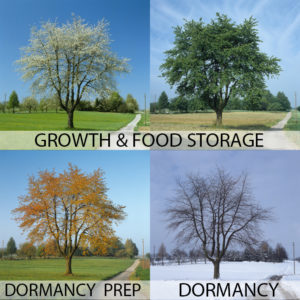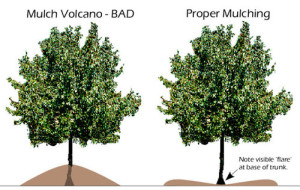 As this cold front descends on the DC Metro Area, it looks like we’re departing from the chilly nights of fall and moving into the freezing days of winter. During the next few weeks, your trees will be preparing themselves for a season of cold weather, winds, and snowfall. To minimize the winter stress your tree will experience, help your tree prepare for winter using the tips below.
As this cold front descends on the DC Metro Area, it looks like we’re departing from the chilly nights of fall and moving into the freezing days of winter. During the next few weeks, your trees will be preparing themselves for a season of cold weather, winds, and snowfall. To minimize the winter stress your tree will experience, help your tree prepare for winter using the tips below.
How Your Tree Prepares For Winter:
Step 1: The first step in preparing for dormancy is to limit the energy needed to survive. Trees do this by releasing a chemical called ABA (Abscisic acid). It suspends growth and is what makes your tree shed its leaves.
Step 2: The second step is to prevent freezing. They do this by making a natural anti-freeze. In late fall, trees pump natural sugars through their systems which lower the freezing point inside their cells keeping the water from freezing and causing damage.
Tips To Help Your Tree Prepare For Winter:
 Mulch:
Mulch:
Mulching insulates a tree’s roots helping protect it from cold weather. It also helps the soil retain moisture and organic matter throughout the seasons but especially in winter when these nutrients can be hard to come by. Mulch your tree’s critical root zone about 2 to 3 inches deep but DO NOT pile the mulch up around the tree’s base/trunk.
Learn More About Proper Mulching & Its Benefits.
Fertilize:
Applying organic fertilizer (bio-stimulants) in the fall provides your tree with the nutrients it needs to promote root growth and protect itself from winter damage. This will help your tree stay healthy throughout the winter and push out beautiful new growth in the Spring.
Prune Deadwood:
Dead, dying, and diseased branches are prone to snapping off trees and falling during winter winds and storms. Not only does this pose a threat to your safety but it also hurts your tree. Unlike pruning, when branches snap it doesn’t make a clean cut. Instead, the bark rips and tears creating open wounds that attract insects and diseases looking to overwinter in your tree. Instead of letting this deadwood snap during storms, proactively prune these branches for your tree’s health and your safety.
 Spray Your Evergreens:
Spray Your Evergreens:
Most of the negative effects of winter stem from the fact that trees and shrubs lose moisture through their pores which are located on their leaves/needles. During the winter months, the dry air and wind accelerate this effect leading to leaves increasing their water demand from the roots in order to survive. However, the root system usually has a hard time keeping up with the leaves’ demands. The result: leaves and needles turning brown and dying. This cycle is called winter burn, or desiccation.
Anti-desiccant treatments can solve this destructive cycle. Anti-desiccants coat the upper and lower foliage in a protective wax coating reducing the moisture lost through the leaves. Similar to the moisturizers, lotions, and humidifiers we use to keep our skin hydrated in the winter, anti-desiccants provide trees & shrubs with the protection they need to flourish during winter instead of fighting to survive. On an aesthetic note, this means no more brown and dying evergreens!
Learn more about Anti-Desiccant Treatments
Wrap Your Young Trees:
Sunscald is winter damage that is commonly seen on young trees, newly planted trees, and thin-barked trees (cherry, crabapple, honey locust, linden, maple, mountain ash, plum). Sunscald caused the tree bark to dry and crack. The University of Minnesota explains that “On cold winter days, the sun heats up bark to the point where cambial activity is stimulated. When the sun is blocked by a cloud, hill, or building, bark temperature drops rapidly, killing the active tissue” creating sunscald.
To combat this you can wrap your susceptible trees with tree wrap this winter. We suggest purchasing burlap tree wrap and following simple application tutorials online to protect your trees in winter.

Prevent Stress From Deer Damage:
Deer damage can be costly, unsightly, and even pose a health risk to your family and your tree. During the harsh winter months when the food supply is low, deer will feast on your plants and tear apart your gardens. This damage will stress your tree and can weaken its defenses. Annually this damage exceeds $2 billion nationwide. If that wasn’t bad enough, they also bring deadly disease-carrying travelers into your yard threatening the safety of your loved ones.
Fortunately, because deer go after the best tasting & easily accessible foliage, simple precautions can be taken to deter them from your property. However; this means if your neighbors have a deer protection program and your property doesn’t, your trees & shrubs will be the most appealing to hungry deer.
Learn more about our Deer Management Program
Need Help With Preparing Your Trees For Cold Weather?
Meet With A Certified Arborist


